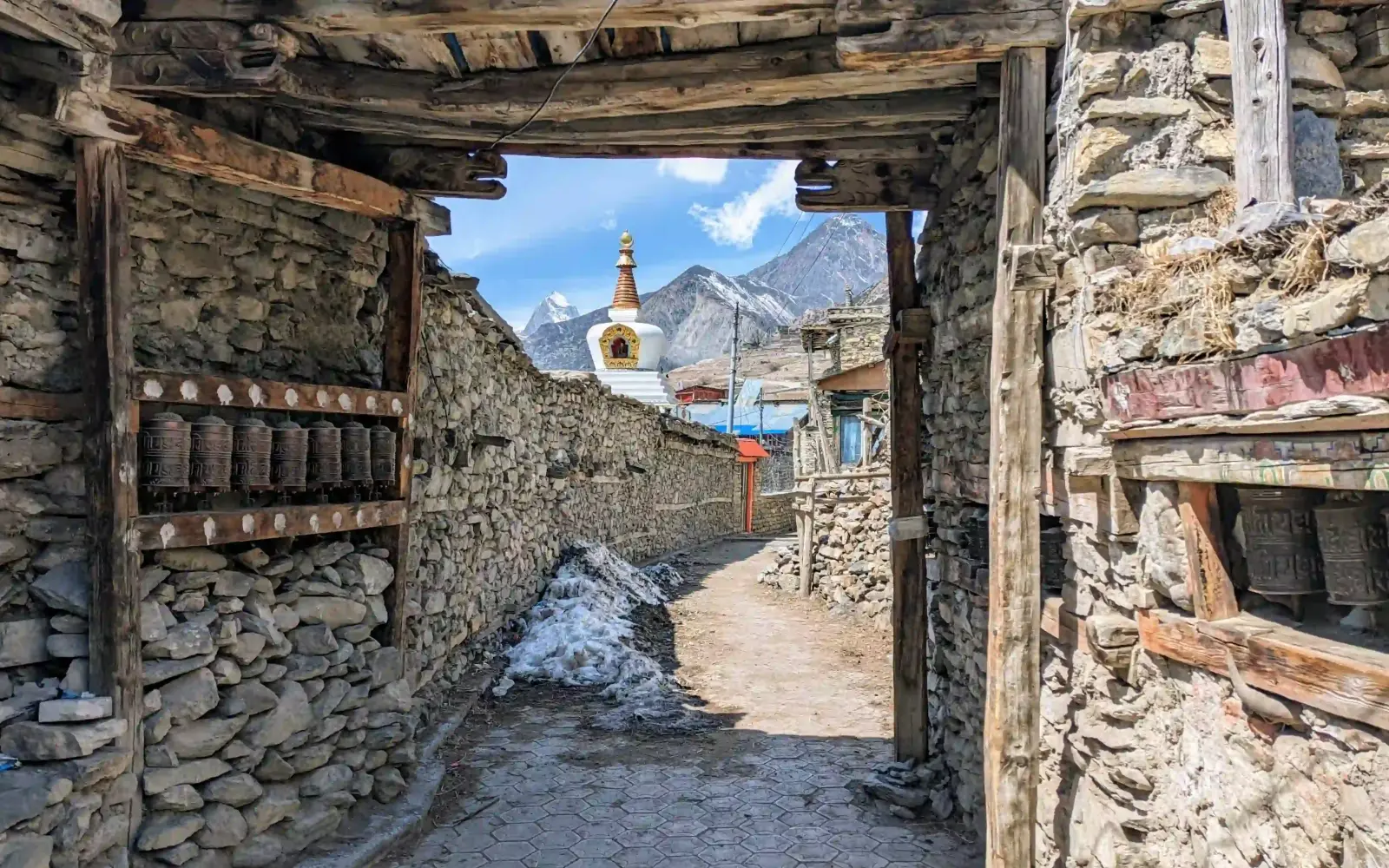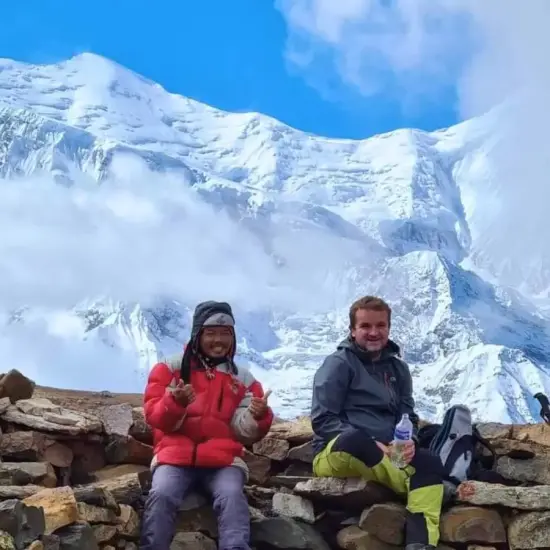The Annapurna Circuit Trek offers one of the most complete trekking infrastructures in the Himalayas.
The Annapurna Circuit is not just about the trail — it’s also about the people who open their homes to trekkers. Whether you’re sipping butter tea in Pisang or enjoying a Thakali meal in Jomsom, each village offers a glimpse of Himalayan hospitality that defines Nepal’s trekking culture.
Understanding Teahouse Accommodation in Nepal
Teahouses are family-run mountain lodges that provide basic but cozy accommodation. A standard teahouse room includes two single beds with mattresses, pillows, and blankets. Toilets may be shared, and hot showers (solar or gas) are available for an extra charge.
Before diving into the route, it’s important to know how teahouses work:
Rooms
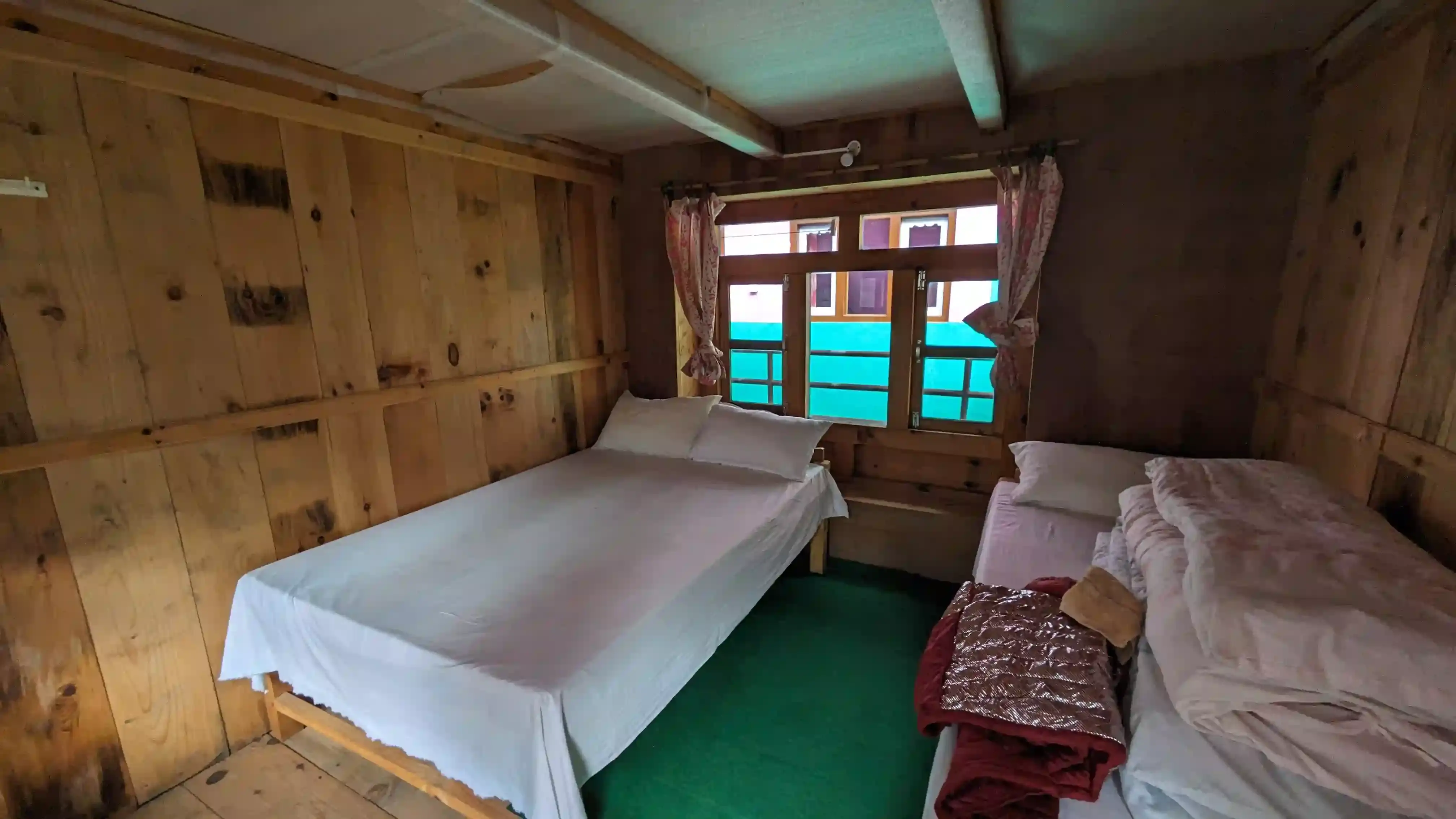 A standard teahouse room includes two single beds with foam mattresses, pillows, and warm blankets. At lower elevations, you may find private rooms with attached bathrooms and hot showers.
A standard teahouse room includes two single beds with foam mattresses, pillows, and warm blankets. At lower elevations, you may find private rooms with attached bathrooms and hot showers.
As you gain altitude—especially above 3,500 meters—rooms become simpler, with shared toilets and limited insulation.
Windows are single-paned, and walls are thin, so rooms can get cold at night. A warm sleeping bag is strongly recommended, especially in areas above Manang or Thorung Phedi. Despite their simplicity, teahouse rooms are clean, cozy, and managed with local hospitality.
Dining Halls
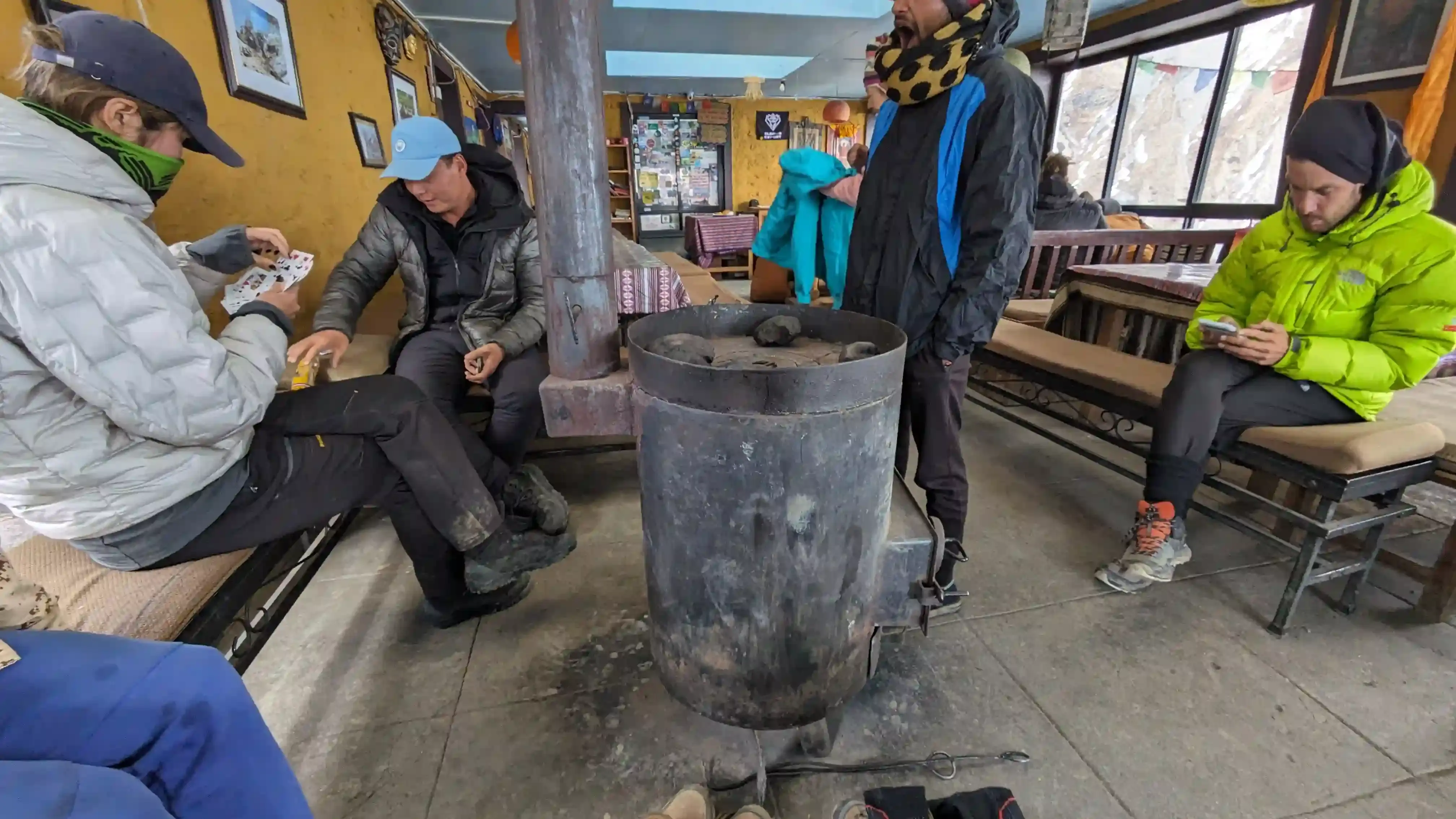 Every teahouse has a communal dining hall, usually heated by a central yak-dung or wood stove. This is the heart of the lodge—where trekkers eat, charge devices, dry clothes, and socialize.
Every teahouse has a communal dining hall, usually heated by a central yak-dung or wood stove. This is the heart of the lodge—where trekkers eat, charge devices, dry clothes, and socialize.
Dining rooms are lined with wooden benches or long tables, and meals are served on a fixed menu system regulated by the Annapurna Conservation Area Project (ACAP) to maintain fair prices.
Electricity, Wi-Fi & Showers
Most villages on the Annapurna Circuit have solar or hydroelectric power. Charging your devices often costs between NPR 100–500.
Wi-Fi is available in most places below 4,000 m but gets unreliable higher up. Hot showers are gas or solar-powered and may cost NPR 200–500 per person.
Trek the Annapurna Circuit Trek
A legendary high-altitude trek in Nepal that encircles the Annapurna Massif, offering dramatic scenery, diverse cultures, and the iconic crossing of Thorong La Pass at 5,416 meters.
Annapurna Circuit Village-by-Village Guide
Day 1: Drive from Kathmandu to Dharapani (1,860m / 6,102ft)
Village: Dharapani
Community: Predominantly Gurung and Tibetan-influenced locals.
Teahouses: Around 10–12 lodges.
Stay & Food: Dharapani marks the start of the Annapurna Circuit for most trekkers. Teahouses here are simple but reliable, with twin-bed rooms, shared bathrooms, and occasional hot showers. Most have stone or wooden construction with dining halls that feature wood-burning stoves to keep trekkers warm. The food menu typically includes dal bhat, fried noodles, pancakes, and tea.
Day 2: Trek to Chame (2,670m / 8,760ft)
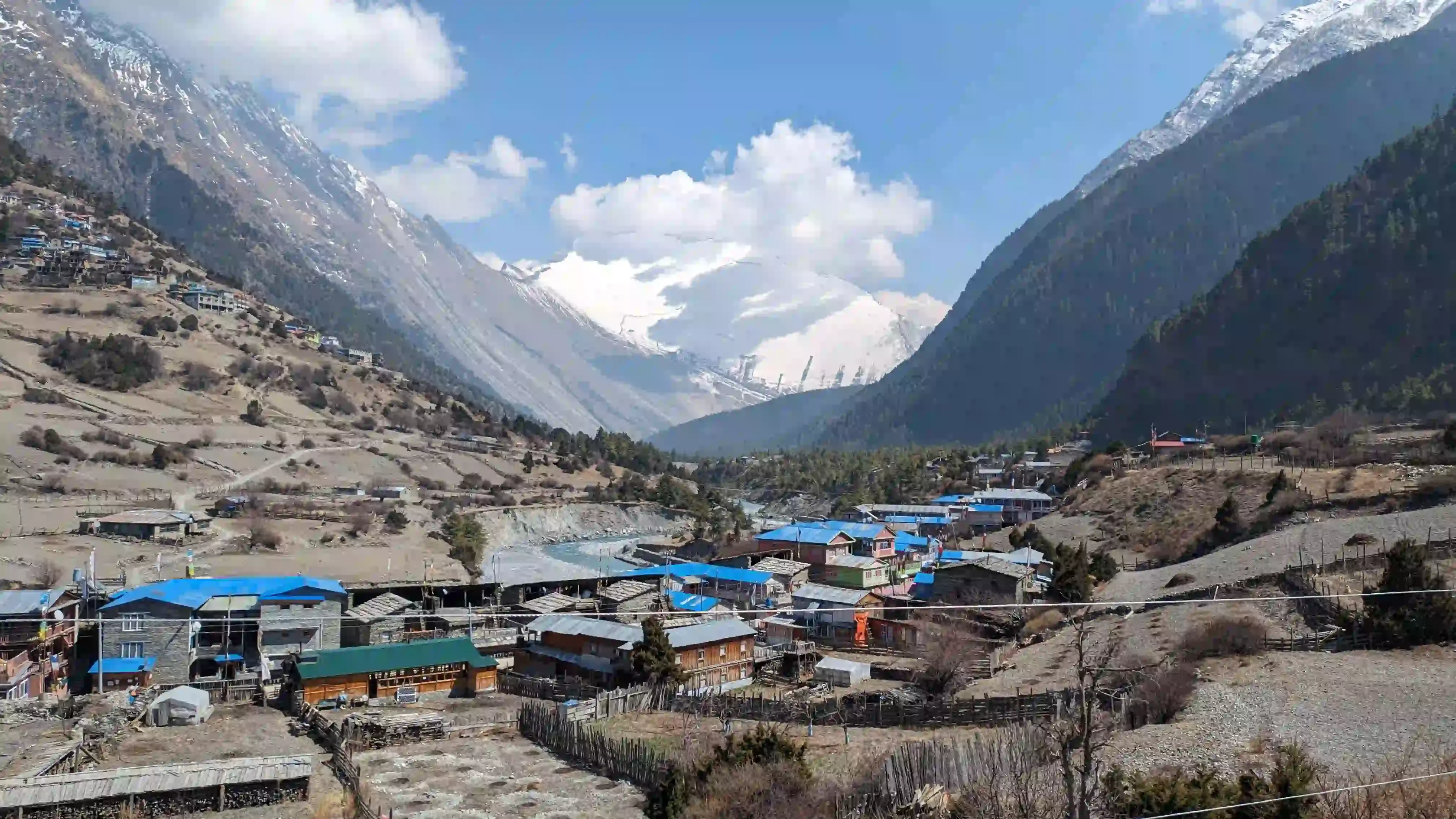
Village: Chame – the district headquarters of Manang.
Community: A mix of Gurung, Tamang, and Tibetan settlers.
Teahouses: About 15–20 well-established lodges.
Stay & Food: Chame offers comfortable accommodation with better insulation and attached bathrooms in some lodges. Most teahouses have solar-heated showers and Wi-Fi. The dining halls are cozy, often decorated with Tibetan prayer flags and wooden interiors. Meals are cooked fresh, including buckwheat pancakes, momos, and local yak cheese pizza
Day 3: Trek to Pisang (3,300m / 10,826ft)
Village: Lower Pisang and Upper Pisang.
Community: Tibetan Buddhist villages with traditional stone houses and prayer wheels.
Teahouses: 8–10 in Lower Pisang and 6–8 in Upper Pisang.
Stay & Food: Upper Pisang offers better mountain views but slightly fewer teahouses. Rooms are basic but clean, with wooden beds, blankets, and communal dining areas. The dining halls are the heart of the lodge, heated by yak dung or wood stoves. Common meals include garlic soup (good for altitude), Tibetan bread, and Sherpa stew.
Day 4: Trek to Manang (3,500m / 11,482ft)
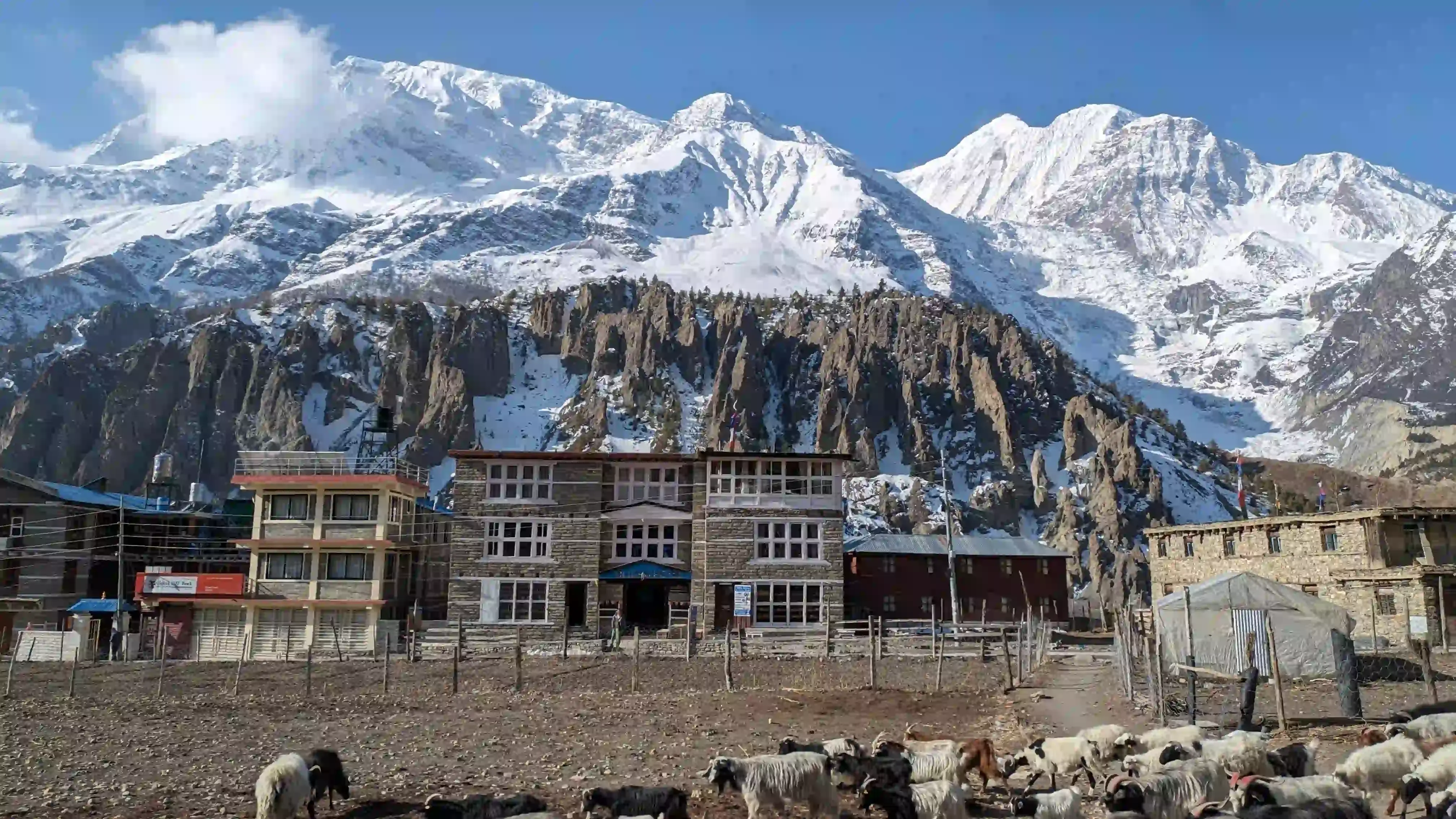
Village: Manang – one of the largest settlements on the circuit.
Community: Manangi people, culturally Tibetan.
Teahouses: Over 30 teahouses and hotels.
Stay & Food: Manang is a major acclimatization stop with some of the best teahouses on the trek. Many lodges offer private bathrooms, electric blankets, and bakeries. You can enjoy apple pies, yak burgers, espresso coffee, and lasagna alongside traditional Nepali meals. The village has several bakeries and a movie hall. Dining halls are large, well-heated, and social hubs for trekkers.
Day 5: Acclimatization Day in Manang
Spend your rest day exploring nearby attractions such as Gangapurna Lake, Praken Gompa, or Ice Lake. You can dine at the Tilicho Bakery or Himalayan Café, known for fresh coffee and pastries. Teahouses also serve porridge, fried rice, and thukpa to help you recover for the next day’s climb.
Day 6: Trek to Yak Kharka (4,000m / 13,123ft)
Village: Yak Kharka
Community: Sparse settlement used for yak grazing, run by locals from Manang.
Teahouses: 4–5 lodges.
Stay & Food: The rooms are smaller and more rustic. Expect simple wooden beds, limited electricity, and common toilets. Dining halls are smaller but warm, serving dal bhat, noodle soup, and hot lemon tea. Since supplies are carried by porters and mules, food costs are slightly higher.
Day 7: Trek to Thorung Phedi (4,450m / 14,599ft) with High Camp Option (4,880m / 16,010ft)
Villages: Thorung Phedi and High Camp
Community: Seasonal settlement for trekkers and guides.
Teahouses: 2–3 in Phedi, 1–2 in High Camp.
Stay & Food: Thorung Phedi has a large stone-built lodge known as Hotel New Phedi, which accommodates over 100 trekkers. Rooms are dormitory-style, but clean and organized. High Camp is colder and windier, offering limited beds but close proximity to the Thorung La Pass. The menu is limited to carbohydrate-rich meals such as pasta, fried potatoes, porridge, and tea. Dining halls are heated but crowded in peak season.
Day 8: Trek to Muktinath via Thorung La Pass (5,416m / 17,769ft) and Drive to Jomsom
Villages: Muktinath and Jomsom
Community: Muktinath – Hindu and Buddhist mix; Jomsom – Thakali community.
Teahouses: Muktinath has 10–12 lodges; Jomsom has over 20 hotels and guesthouses.
Stay & Food: Muktinath lodges are modern, with attached bathrooms and reliable hot showers. Pilgrims and trekkers mingle here, and meals range from Indian curries to Thakali sets. In Jomsom, accommodation upgrades to hotel-level comfort with hot showers, power outlets, and clean beds. Try the famous Thakali thali, apple cider, and bakery items from the local Marpha apples.
Day 9: Jeep Ride to Pokhara (884m / 2,900ft)
Pokhara Stay & Food: Pokhara is Nepal’s tourism hub, filled with hundreds of hotels, lakeside restaurants, and cafés. After days of high-altitude trekking, you can enjoy hot showers, Western meals, and fresh coffee. Lodges range from budget guesthouses to luxury resorts.
Day 10: Drive Back to Kathmandu (1,350m / 4,429ft)
Your trek concludes with a comfortable return to Kathmandu. Thamel offers a wide range of accommodations — from hostels to boutique hotels — where trekkers can unwind and explore the city’s food scene.
Final Advice for Trekkers
Bring a sleeping bag rated for -10°C.
Carry small cash (NPR 100–500 notes) for paying lodge and charging fees.
Choose dal bhat at least once daily—high energy, unlimited refills.
Acclimatize properly in Manang and ascend gradually.
Book teahouses early during October–November (peak season).
Trek the Manaslu and Annapurna Circuit with Tilicho Lake Trek
Manaslu, Annapurna & Tilicho – Nepal’s Best Trek!
What Each Day Looks Like on the Annapurna Circuit Trek
A typical day on the Annapurna Circuit Trek follows a well-paced rhythm shaped by mountain life, the terrain, and teahouse culture.
Each day blends physical challenge with comfort, as trekkers move between villages connected by a reliable chain of lodges. Here’s what your average day on the trail looks like from morning to evening.
Morning:
Your day begins around 6:30 AM with a cup of tea or coffee in the dining hall. After breakfast — often porridge, eggs, or Tibetan bread — you pack up and start trekking by 7:30–8:00 AM. Mornings are peaceful, with villagers tending to fields or herding yaks along stone-paved paths.Daytime Trek:
Expect to walk 5–7 hours a day, crossing forests, waterfalls, and prayer-flag-lined trails. Villages like Dharapani, Chame, Pisang, and Manang have anywhere from 3 to 15 teahouses, depending on size and altitude. The locals — mainly Gurung, Manangi, and Thakali people — are welcoming and take pride in their mountain hospitality.Lunch Stop:
Lunch is usually taken around midday at a teahouse en route, serving freshly cooked Dal Bhat, noodles, or fried rice. Meals are homemade using local ingredients and prepared on wood stoves.Afternoon and Arrival:
Trekkers typically reach the next stop by 3:00–4:00 PM. After checking in, you can rest, sip tea, or try apple pie — a local favorite. Rooms are simple yet comfortable, with two single beds, warm blankets, and shared bathrooms. Facilities become more basic as altitude increases, but every stop ensures warmth and rest.Evening:
Dinner is served around 6:30 PM in the main dining hall — the heart of every teahouse, heated by a yak-dung stove. Trekkers gather here to eat, chat, or read under solar lights. After dinner, your Places Nepal guide will give a short briefing about the next day’s route, weather conditions, and safety tips, ensuring everyone is well-prepared for the trek ahead. By 9:00 PM, most trekkers head to bed, ready for another day in the Himalayas.
Trek the Nar Phu Valley Trek with Annapurna Circuit
Two Trails, One Epic Adventure – Venture Into the Hidden Nar Phu Valley and Conquer the Annapurna Circuit

